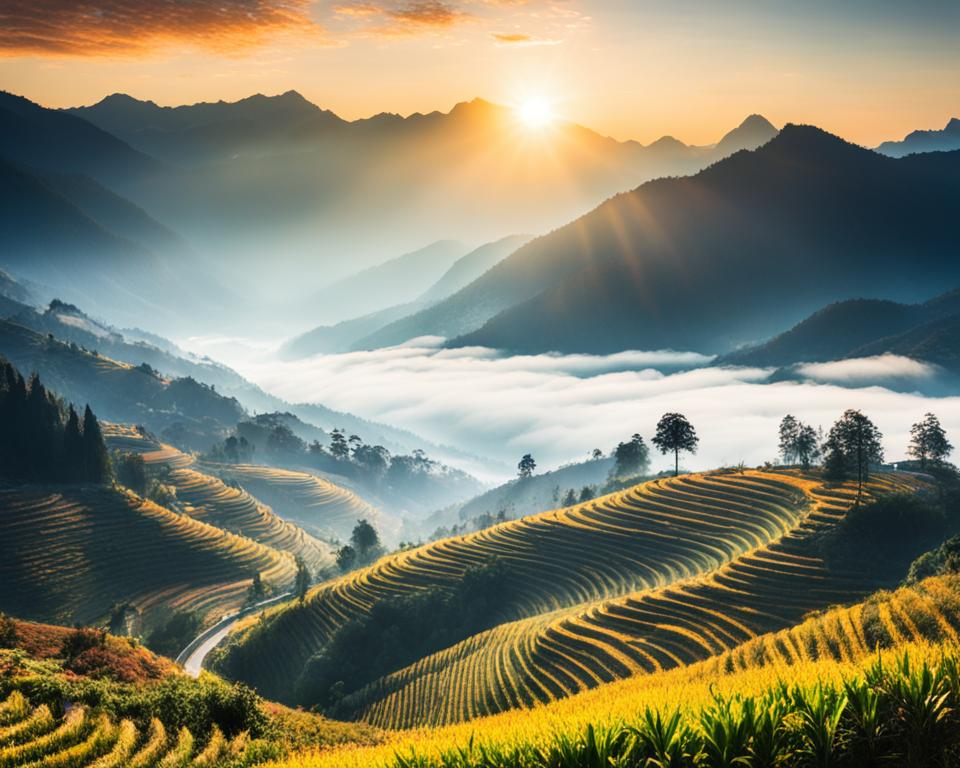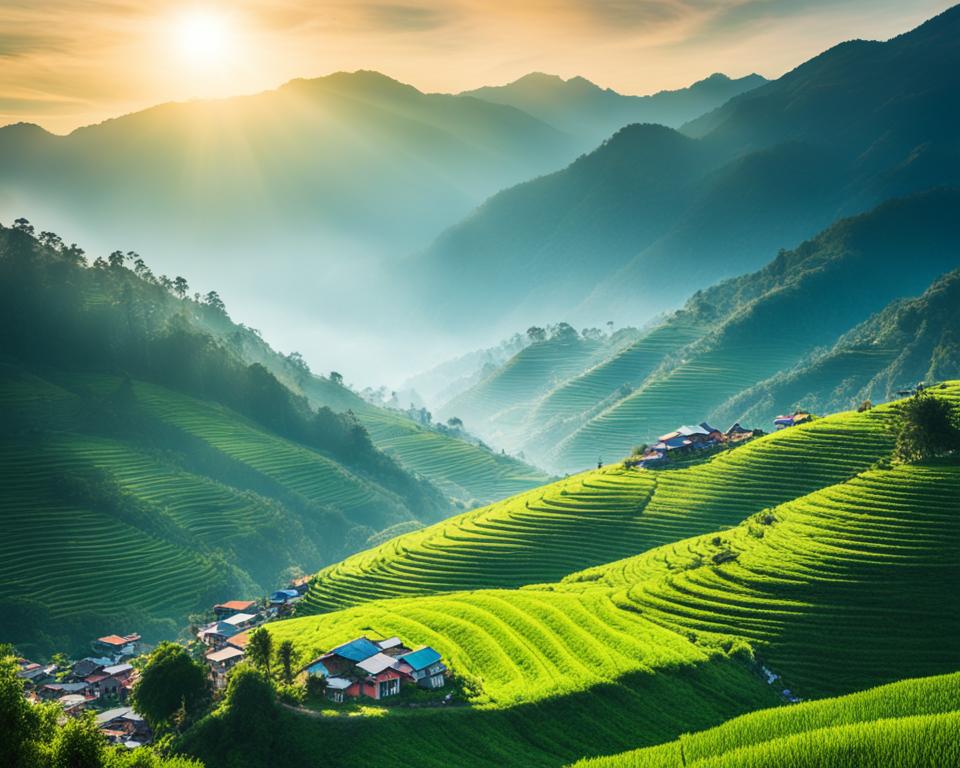Sa Pa is a captivating hill town located in the Lao Cai province of northern Vietnam. Nestled among the rugged Hoang Lien Son mountain range, this enchanting destination offers visitors a unique blend of stunning natural scenery, rich cultural heritage, and outdoor adventure. From the awe-inspiring rice terraces that cascade down the mountainsides to the towering peaks of Fansipan Mountain, Sa Pa enchants all who visit with its breathtaking landscapes.
The town’s vibrant ethnic minority communities, such as the H’mong and Dao, showcase their traditional dress, handicrafts, and customs, providing travelers with a glimpse into the region’s rich cultural tapestry. Sa Pa’s French colonial architecture, a legacy of its past as a hill station, adds to the town’s allure, creating a charming and picturesque atmosphere. As a premier trekking destination, Sa Pa draws adventurers from around the world who come to explore the Muong Hoa Valley and challenge themselves on the trails leading to the summit of Fansipan, the “Roof of Indochina.”
Read interesting things at : apportfolioasia
Key Takeaways
- Sa Pa is a captivating hill town in northern Vietnam, offering a unique blend of natural beauty, cultural heritage, and outdoor adventure.
- The town’s stunning rice terraces, towering peaks, and vibrant ethnic minority communities are major draws for visitors.
- Sa Pa’s French colonial architecture adds to its allure, creating a charming and picturesque atmosphere.
- As a premier trekking destination, Sa Pa attracts adventurers from around the world who come to explore the Muong Hoa Valley and Fansipan Mountain.
- The town’s rich cultural tapestry and well-preserved traditions offer travelers a unique and immersive experience.
Introduction to Sa Pa: A Hidden Gem in the Mountains
Nestled among the rugged Hoang Lien Son mountain range in northwestern Vietnam, Sa Pa is a captivating hill town that has long been a hidden gem in the country’s tourism landscape. The town’s breathtaking natural beauty, with its sprawling rice terraces, lush forests, and towering peaks, has made it a prime destination for trekkers, nature lovers, and those seeking to immerse themselves in the cultural richness of northern Vietnam.
Sa Pa’s Captivating Landscape
The Lao Cai province, where Sa Pa is situated, is renowned for its stunning mountain scenery. The town’s location in the heart of the Hoang Lien Son range offers visitors a chance to experience the region’s diverse and awe-inspiring landscapes, from the cascading rice terraces that paint the hillsides in shades of green and gold to the majestic peaks that tower over the town, including the iconic Fansipan Mountain, the “Roof of Indochina.”
A Brief History of Sa Pa
Sa Pa‘s origins can be traced back to the late 19th century when the French established a hill station in the area, drawn by the town’s temperate climate and breathtaking mountain scenery. The legacy of this French colonial history can be seen in the town’s charming architecture, which blends European and Vietnamese influences to create a unique and captivating aesthetic. Over the years, Sa Pa has evolved into a premier trekking destination in northern Vietnam, attracting adventurers and nature enthusiasts from around the world.
Trekking in Sa Pa: Discovering Nature’s Wonders
The rugged and picturesque landscapes of Sa Pa make it a premier trekking destination in northern Vietnam. One of the most popular hikes is the trek through the Muong Hoa Valley, where visitors can immerse themselves in a natural wonderland of lush forests, cascading waterfalls, and terraced rice fields. Along the way, trekkers have the opportunity to interact with the local ethnic minority communities, such as the H’mong and Dao, and learn about their traditional way of life.
Exploring the Muong Hoa Valley
The Muong Hoa Valley is a true gem of Sa Pa, offering visitors a chance to witness the breathtaking beauty of the region’s natural landscapes. Trekkers can wander through the valley’s winding trails, taking in the stunning vistas of verdant forests, cascading waterfalls, and the characteristic terraced rice fields that cling to the mountainsides. Along the way, they’ll have the chance to engage with the local ethnic minority communities, learning about their traditions and way of life.
Conquering Fansipan Mountain
For those seeking a greater outdoor adventure, the challenge of summiting Fansipan Mountain, the “Roof of Indochina,” beckons. This majestic peak, standing at an impressive 3,143 meters (10,312 feet), offers trekkers an opportunity to test their endurance and climbing skills while being rewarded with breathtaking panoramic views of the surrounding mountain scenery. The hiking trails leading to the summit are well-maintained and offer a range of difficulty levels, catering to both experienced mountaineers and adventurous novices.
Sa Pa’s Vibrant Ethnic Minority Culture
One of the most captivating aspects of Sa Pa is the vibrant culture of its ethnic minority communities, particularly the H’mong and Dao people. These groups have maintained their traditional dress, customs, and way of life for centuries, and their presence adds a unique and authentic dimension to the town’s cultural tapestry.
Traditional Dress and Customs
The H’mong and Dao people are known for their intricate and colorful traditional attire, which is a testament to their rich cultural heritage. From the embroidered and brocaded outfits of the H’mong women to the distinctive headdresses and intricate silver jewelry of the Dao, the traditional dress of these ethnic minorities is a visually stunning display of their artistic prowess and cultural identity.
Beyond their traditional dress, the H’mong and Dao communities in Sa Pa also maintain a wealth of customs and practices that have been passed down through generations. This includes rituals, festivals, and everyday traditions that offer visitors a glimpse into the deep-rooted cultural traditions of northern Vietnam.
Local Handicrafts and Markets
The creative spirit of Sa Pa’s ethnic minority communities is also evident in their vibrant local markets and the stunning handicrafts they produce. From the intricate embroidery and batik textiles to the delicately carved wooden figurines and metalwork, the artisanal products found in Sa Pa’s markets are a testament to the skilled craftsmanship of the H’mong, Dao, and other ethnic groups.
Visitors to Sa Pa can immerse themselves in the lively atmosphere of these local markets, where they can interact with the artisans, learn about the techniques and symbolism behind the handicrafts, and purchase unique souvenirs to take home and cherish.
Sa Pa: A Trekker’s Paradise
Nestled amidst the captivating landscapes of northern Vietnam, Sa Pa has earned a reputation as a true trekker’s paradise. The town’s proximity to the majestic Hoang Lien Son mountain range, with its towering peaks, lush forests, and cascading waterfalls, provides a myriad of hiking and outdoor adventure opportunities for visitors of all skill levels.
Trekking enthusiasts flock to Sa Pa to explore the region’s well-developed trail system, which offers a diverse range of routes catering to a variety of interests and fitness levels. From leisurely strolls through the Muong Hoa Valley to challenging ascents to the summit of Fansipan Mountain, the “Roof of Indochina,” Sa Pa’s natural landscapes are a true outdoor adventure playground.
As you navigate the winding paths that weave through Sa Pa’s rolling hills and valleys, you’ll be captivated by the breathtaking mountain scenery that surrounds you. Verdant forests give way to sprawling rice terraces that cascade down the mountainsides, creating a mesmerizing patchwork of greens and golds.
Whether you’re a seasoned hiker or a nature enthusiast seeking a peaceful escape, Sa Pa’s trekking opportunities offer an unparalleled experience to immerse yourself in the beauty and tranquility of Vietnam’s northern wilderness. With its well-marked trails, knowledgeable local guides, and stunning vistas, this enchanting town truly is a trekker’s paradise waiting to be explored.

Sa Pa’s Breathtaking Rice Terraces
The Muong Hoa Valley, located just a short distance from the Sa Pa town center, is home to some of the most picturesque and well-preserved rice terraces in the region. These expansive, cascading rice terraces are a true testament to the ingenuity and hard work of the local ethnic minority communities, who have cultivated these stunning landscapes for generations.
The Best Seasons to Visit
The best time to witness the beauty of Sa Pa’s rice terraces varies throughout the year, with each season offering a unique and captivating perspective. During the spring months, the terraces come alive with a vibrant green hue as the new rice crop is planted. In the summer, the terraces are lush and verdant, with the rice plants reaching their full height. The autumn harvest season is particularly special, as the terraces transform into a patchwork of golden hues. And in the winter, the terraces take on a serene, snow-capped beauty, creating a truly magical backdrop.
Photography Tips for Capturing the Terraces
Capturing the breathtaking beauty of Sa Pa’s rice terraces through the lens is a rewarding challenge for photographers of all skill levels. To make the most of your time in the Muong Hoa Valley, consider the following tips:
- Arrive early in the morning or late in the afternoon to take advantage of the soft, warm light and avoid harsh shadows.
- Experiment with different vantage points, including higher elevations and drone photography, to showcase the scale and depth of the terraces.
- Pay attention to the changing seasons and weather conditions, as they can dramatically alter the appearance of the rice fields.
- Engage with the local farmers and communities to capture authentic, candid moments of daily life in the terraces.
Sa Pa’s French Colonial Architecture
The legacy of Sa Pa’s French colonial past can be seen in the town’s charming and well-preserved architecture, which combines European and Vietnamese influences to create a unique and captivating aesthetic. As a former hill station established by the French in the late 19th century, Sa Pa boasts a collection of historic buildings and structures that evoke the town’s rich history and cultural heritage.
Exploring the Old Town
Wandering through Sa Pa’s old town is like stepping back in time, as the well-preserved French colonial buildings line the streets, creating a picturesque and atmospheric setting. Visitors can admire the intricate architectural details, such as the elaborate facades, wrought-iron balconies, and terracotta roof tiles, which showcase the skilled craftsmanship of the era. Many of these historic structures have been meticulously restored and repurposed, now housing a variety of shops, cafes, and hotels that cater to the town’s thriving tourism industry.
Beyond the charming old town, Sa Pa’s French colonial legacy can be seen in the town’s grand, centrally located church, as well as the former governor’s residence, which now serves as a museum showcasing the town’s history and cultural heritage. These well-preserved buildings not only offer a glimpse into Sa Pa’s past but also highlight the importance of heritage preservation in maintaining the town’s unique character and appeal.

Where to Stay in Sa Pa
Sa Pa offers a diverse range of accommodation options to suit the needs and preferences of all travelers. From luxurious resorts perched atop the Hoang Lien Son mountain range to authentic local
homestays
immersed in the heart of the town’s vibrant
ethnic minority culture
, there is something for every type of visitor.
Luxury Resorts and Eco-Lodges
For those seeking a truly elevated
sa pa
experience, the town boasts a selection of high-end
luxury resorts
and eco-friendly
lodges
that seamlessly blend modern comforts with the surrounding natural beauty. These properties often feature stunning mountain vistas, rejuvenating spa services, and exceptional dining experiences that showcase the best of local and international cuisine.
Local Homestays for an Authentic Experience
Travelers looking to immerse themselves in the true spirit of
sa pa
can opt for a stay in one of the town’s traditional
homestays
. These intimate accommodations offer visitors the opportunity to live alongside the
local community
, learn about their daily lives, and gain a deeper understanding of the region’s rich
cultural heritage
. From cozy family-run guesthouses to community-based initiatives, these unique lodgings provide an authentic and unforgettable glimpse into the heart of Sa Pa.
Whether you seek the lap of luxury or the comforts of a local home, Sa Pa’s diverse
accommodation
options ensure that there is a perfect fit for every traveler’s preferences and budget.
Sa Pa’s Cuisine: A Delightful Fusion of Flavors
The culinary landscape of Sa Pa is a delightful fusion of Vietnamese and ethnic minority influences, offering visitors a unique and flavorful gastronomic experience. From hearty, traditional dishes to innovative contemporary creations, the town’s diverse array of eateries and street food vendors cater to a wide range of tastes and preferences.
Must-Try Local Dishes
No visit to Sa Pa is complete without savoring the local specialties that showcase the region’s rich cultural heritage. One such dish is the Thang Co, a slow-cooked stew made with a variety of meats, herbs, and spices that is a staple among the H’mong and Dao ethnic minority groups. Another must-try is the Banh Mi, a classic Vietnamese sandwich that features a delicious blend of savory fillings and crispy, freshly baked bread.
Street Food and Market Favorites
The vibrant local markets and bustling street food stalls of Sa Pa offer a tantalizing array of culinary delights that provide a glimpse into the town’s lively food culture. From the fragrant Pho (Vietnamese noodle soup) to the sweet and sticky Xoi (sticky rice), the diverse range of street food options caters to every palate. Exploring the local markets, such as the Bac Ha Sunday Market, allows visitors to discover unique ethnic minority dishes and purchase fresh, locally sourced ingredients to take home.
| Must-Try Local Dishes | Street Food and Market Favorites |
|---|---|
| Thang Co (H’mong and Dao stew) | Pho (Vietnamese noodle soup) |
| Banh Mi (Vietnamese sandwich) | Xoi (sticky rice) |
| Grilled Chicken with Lemongrass | Fried Spring Rolls |
| Steamed Rice Cakes | Grilled Skewered Meats |
Getting to Sa Pa: A Journey Through Stunning Landscapes
Reaching the enchanting town of Sa Pa is part of the adventure, as the journey itself offers travelers the opportunity to immerse themselves in the stunning landscapes of northern Vietnam. Whether you choose to travel by train or navigate the winding mountain roads, the journey to Sa Pa is a scenic and unforgettable experience.
Traveling by Train
One of the most popular and convenient ways to reach Sa Pa is by train. The railway network in Lao Cai province, where Sa Pa is located, provides a comfortable and scenic journey through the mountainous terrain. Travelers can board the train in major cities like Hanoi and sit back as the train winds its way through the picturesque landscapes, offering breathtaking views of the sa pa region’s towering peaks, lush forests, and cascading waterfalls.
Navigating the Winding Mountain Roads
For those seeking a more adventurous journey, the winding mountain roads leading to Sa Pa offer a thrilling and visually captivating experience. The drive from Lao Cai city, the provincial capital, to Sa Pa is a journey in itself, with the mountain roads winding through a panorama of scenic journeys and stunning landscapes. Along the way, travelers can witness the incredible natural beauty of the Lao Cai province, including the train travel through lush valleys and past mountain roads.
Whether by train or by road, the journey to Sa Pa is an integral part of the overall experience, allowing visitors to fully immerse themselves in the captivating charm of this northern Vietnam destination.
Best Time to Visit Sa Pa
The optimal time to visit the enchanting town of Sa pa can vary depending on your personal preferences and the experiences you hope to have during your stay. Sa pa’s location in the Hoang Lien Son mountain range means that it experiences distinct seasonal changes, each with its own unique charms and considerations.
Peak Season and Crowd Management
The peak season for visiting sa pa typically falls during the summer months of June to August, when the weather is warm and sunny, and the rice terraces are at their most vibrant. This is also the busiest time of year, with crowds of tourists flocking to the town to witness its natural beauty and cultural attractions. To navigate the peak season effectively, it’s essential to plan your trip well in advance and be prepared for crowd management strategies, such as booking accommodations and tickets early.
Off-Season Advantages
While the peak season offers the most favorable weather conditions, the off-season months can also be an excellent time to visit sa pa. During the spring (March to May) and autumn (September to November), the town experiences fewer crowds, allowing for a more intimate and immersive experience. The seasonal changes during these periods can also be breathtaking, with the town’s landscapes transforming with the blooming flowers and changing foliage. Additionally, off-season travel can offer more affordable rates and a chance to interact with the local ethnic minority communities in a less crowded setting.
| Season | Best Time to Visit | Highlights | Crowd Level |
|---|---|---|---|
| Summer (June-August) | Peak season | Warm weather, vibrant rice terraces | High |
| Spring (March-May) | Shoulder season | Blooming flowers, fewer crowds | Moderate |
| Autumn (September-November) | Shoulder season | Changing foliage, fewer crowds | Moderate |
| Winter (December-February) | Off-season | Cooler temperatures, fewer tourists | Low |
Sa Pa’s Sustainable Tourism Initiatives
As a popular tourist destination in northern Vietnam, Sa Pa has placed a strong emphasis on sustainable tourism practices to ensure the long-term preservation of its natural and cultural heritage. Recognizing the importance of balancing economic development with environmental and social responsibility, the town has implemented a range of initiatives aimed at promoting ecologically-conscious travel and protecting its fragile ecosystems.
Eco-Friendly Accommodations
Sa Pa’s commitment to sustainable tourism is evident in the growing number of eco-friendly accommodations that cater to environmentally-conscious travelers. These eco-lodges and resorts prioritize the use of renewable energy, sustainable construction materials, and water conservation practices, minimizing their impact on the local environment. Visitors seeking a more authentic experience can also opt for locally-run homestays, which provide an opportunity to immerse themselves in the traditional way of life of Sa Pa’s ethnic minority communities while supporting the local economy.
Responsible Trekking Practices
Trekking is one of the most popular activities in Sa Pa, but the town has implemented measures to ensure that this activity is carried out in a responsible manner. Tour operators and guides are trained to educate visitors on proper trail etiquette, waste management, and the importance of preserving the delicate mountain ecosystems. Visitors are encouraged to stick to designated trails, avoid disturbing wildlife, and pack out all their waste, ensuring that the natural beauty of Sa Pa remains unspoiled for future generations.
Sa Pa’s Surrounding Attractions
While the enchanting town of Sa Pa is a primary draw for visitors to the region, the surrounding areas also offer a wealth of additional attractions and experiences that are worth exploring. One such gem is the vibrant Bac Ha Sunday Market, located just a short distance from Sa Pa.
Bac Ha Sunday Market
The Bac Ha Sunday Market is a bustling and lively event that showcases the rich cultural tapestry of the local ethnic minority communities, such as the Flower H’mong and Pho Lu. Visitors can immerse themselves in the vibrant sights, sounds, and aromas of the market, where vendors offer a dazzling array of handcrafted textiles, intricate silver jewelry, and traditional herbal medicines. Beyond the market stalls, visitors can also witness cultural performances and demonstrations, providing a deeper understanding of the region’s vibrant heritage.
Lao Cai City
Another must-visit destination near Sa Pa is the city of Lao Cai, the capital of the Lao Cai province. This dynamic urban center serves as a gateway to the northern region of Vietnam and offers a unique blend of modern development and historical charm. Visitors can explore the city’s bustling markets, colonial-era architecture, and museums showcasing the diverse ethnic minority cultures that thrive in the surrounding areas. Lao Cai also provides convenient access to nearby attractions, making it an ideal base for day trips and further exploration of the stunning landscapes and cultural richness of northern Vietnam.



